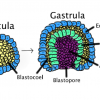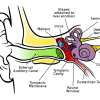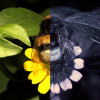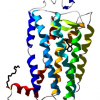Inner Nature: Vaccine Formulations

By Vidya Rajan, Columnist, The Times
In early October, I was listening to Weekend Edition on National Public Radio when an interview with the Executive Director of Shark Allies, Stefanie Brendl, came on the air [1]. Her concern was urgent: a world-wide coronavirus vaccine that could contain the ingredient squalene, isolated from from shark livers, could lead to over a half-million sharks being...
Inner Nature — Fe: An Iron Constitution

By Vidya Rajan, Columnist, The Times
There are 92 naturally occurring elements in the periodic table, but only a handful of elements are essential to life. They include hydrogen, oxygen, carbon, and nitrogen in large quantities, moderate amounts of iron, magnesium, sodium, potassium, phosphorus and sulfur, and miniscule quantities of “micronutrients” like selenium and zinc. Why? In an intermittent...
Inner Nature: Gender — sex made visible

By Vidya Rajan, Columnist, The Times
Charles Darwin concluded his seminal “Origin of Species by Means of Natural Selection” with this immortal paragraph: “Thus, from the war of nature, from famine and death, the most exalted object which we are capable of conceiving, namely, the production of the higher animals, directly follows. There is grandeur in this view of life, with its several powers,...
Inner Nature: Animal Development: Evolution of Body Plans

By Vidya Rajan, Columnist, The Times
To observe a graceful animal in motion is a beautiful thing.
This is even more so for those justly celebrated for their mastery of movement, such as a hummingbird hovering over a flower, or a human thundering to a heart-stopping sub-10 second 100 meter Olympic run. The seeming perfection of form is an illusion – all forms are in development, with each generation...
Inner Nature: The Breath of Life

By Vidya Rajan, Columnist, The Times
Respiration is the technical term for the release of energy from food at the cellular level. On a colloquial level, it is used to describe the process of breathing. Here, I will discuss how the process of breathing using the respiratory system supports the intake of oxygen and removal of carbon dioxide, a waste product of respiration. I am going to focus narrowly...
Inner Nature: Good Vibrations – The Science of Hearing

By Vidya Rajan, Columnist, The Times
A disturbance in any medium except vacuum causes vibrations whose energy is transmitted from atom to atom in all directions from the epicenter. These waves encode the amplitude (intensity) and frequency (pitch)(see Figure 1) of the disturbance thus broadcasting information to anyone who can decode the vibrations. Animals, whose very existence depends on whether...
Inner Nature: Eye see colors

By Vidya Rajan, Columnist, The Times
Eyes harvest light reflected from objects. Optic nerves transmit that information to the brain. The brain turns that information into an image. Thus eyes are the intermediary between an object and its perception. Let’s look at them more carefully. Don’t shrink from anatomical detail or biochemistry – this is fun stuff. It’s fun because delving into biomechanical...
Inner Nature: The eyes have it

By Vidya Rajan, Columnist, The Times
The Earth rotates once on its axis every day, with the resultant periodicity of night following day. The predictability of exposure to the energy sources of light and heat have allowed lifeforms to evolve mechanisms to harvest it during daytime and develop materials to store that energy. All energy that emanates from the Sun is in the form of electromagnetic...
Inner Nature: Metamorphosis – Buggy Development

By Vidya Rajan, Columnist, The Times
The growth of a single cell from a fertilized egg, or zygote, to an adult composed of trillions of cells is amazing and magical. This process which scientists, with their knack for understatement, call “development” happens with most eukaryotic organisms – those that have cells with a nucleus and other membranous compartments. Nucleated eukaryotic cells...
Inner Nature: Aposematism – Worn Warning

By Vidya Rajan, Columnist, The Times
Aposematic coloration refers to the conspicuous colors some animals exhibit to advertise their unpalatability or warn of peril to potential predators. A familiar example is the black and yellow/orange stripes of bees. Black and orange aposematic coloration extends to flatworms (ex. sea slugs), reptiles (ex. coral snakes), fish (ex. lionfish) amphibians (ex....



